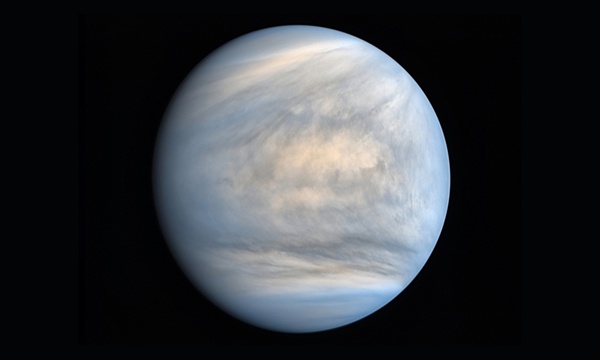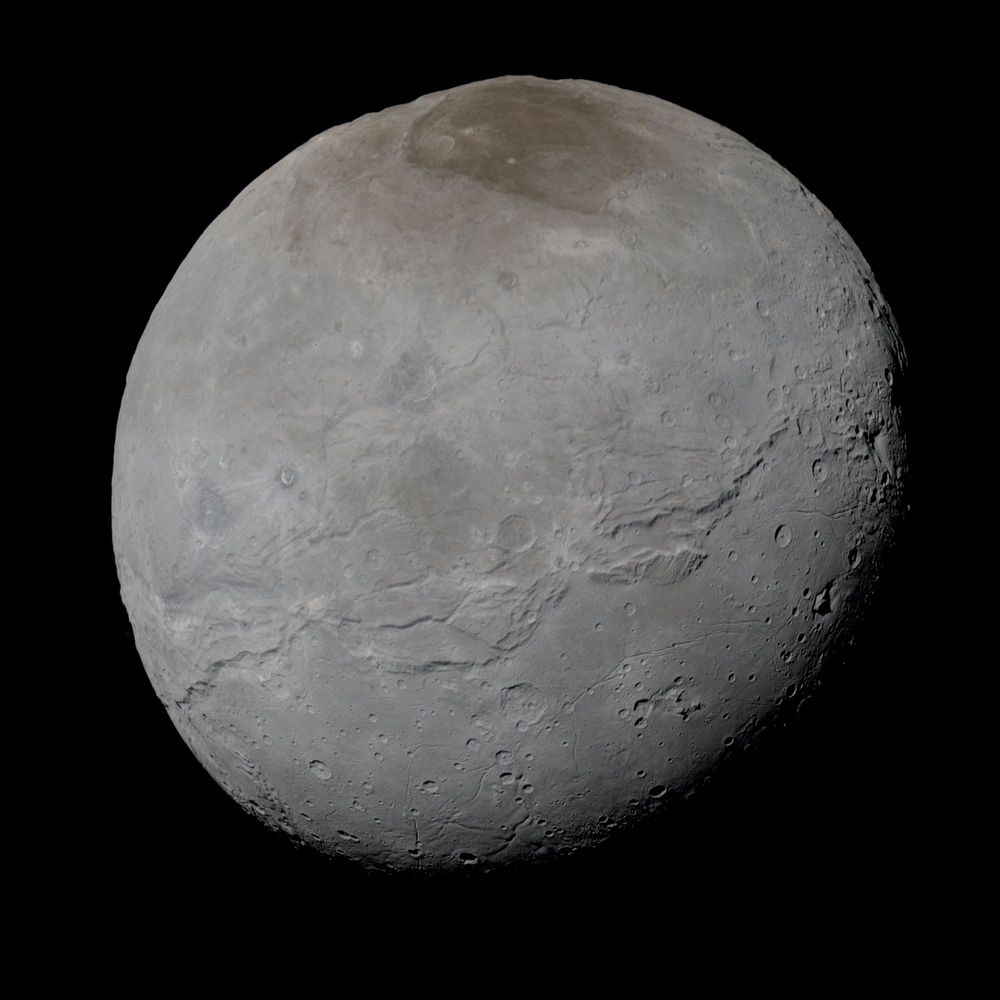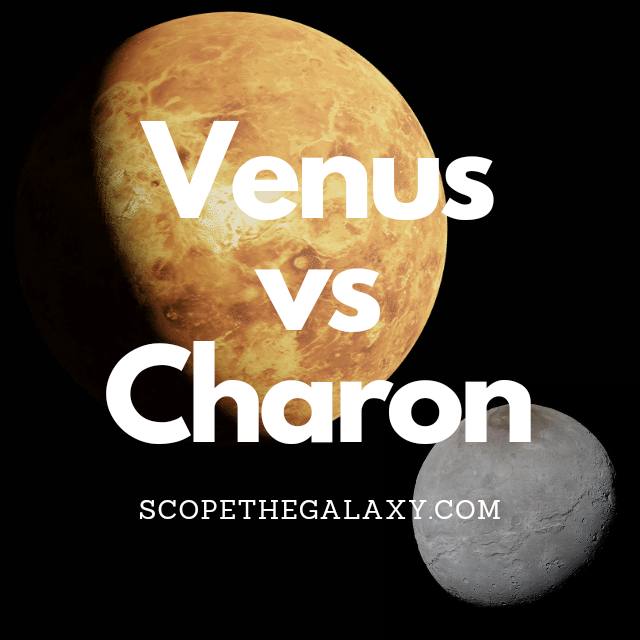*This post may contain affiliate links. This means we may make a commission if you purchase an item using one of our links*
The main differences between Venus and Charon is that Venus is the second largest terrestrial planet in our solar system at 12,104km, the brightest entity and hottest planet in our solar system whilst Charon is Pluto’s largest moon, a low density terrestrial object and is the joint 9th farthest Planet from the Sun whilst Venus is the 2nd closest.
There are various other differences between these two so, continue reading for a more detailed look at each entity along with their similarities and differences below.
What Is The Planet Venus?
Table of Contents

Venus is the 2nd closest planet to the Sun and is often regarded as Earth’s sister planet. It’s very close to our Earth in size where its diameter is 12,104km. This is just over 600km less wide than our home planet.
Unlike all the planets further outside the Sun’s orbit, Venus and even mercury have no moons orbiting it. The most probable reason for this is due to its closer proximity to it, which means that smaller objects orbit the Sun as opposed to Venus.
Venus is also the hottest planet in our solar system where its surface temperature is 475 degrees Celsius. This is due to a number of factors, like the thicker atmosphere, close proximity to Sun, the reasons for which have been explained in more detail here.
It’s core is hot too, similar to that of the ice giants and Earth, where it stands at 5,200 degrees Celsius.
As a result of this thicker atmosphere, Venus is also able to reflect a lot more of the light the Sun projects at it, making it both the hottest and brightness planet in our solar system. This is why for the longest time, and even till this day Venus is often referred to as the morning or evening star.
The thicker atmosphere is mostly compromised of carbon dioxide, and thick clouds of sulfuric acid. This does result sulfuric acid rain on the planets surface, which of course is very corrosive.
Being so close to the Sun also mean its orbital cycle is much shorter. It takes Venus 225 days to complete a full cycle, on the contrary a single day is actually longer than this where it takes around 243 days for a full rotation around its axis.
This is partially down to its distance from the Sun and the thick atmosphere surrounding this terrestrial planet. The axial tilt on Venus is also different from the other planets in our solar system where it is practically straight at 3 degrees.
All in all this is certainly one of the most interesting planets in our solar system and in many peoples eyes, could very well have supported life in the past based on how close its shape and size is to that of Earth.
What Is The Moon Charon?

Charon is the largest of Pluto’s moons, first discovered on 22nd June 1978. The surface of this icy world is frozen with nitrogen and methane ice; it may also hold some water ice. While Pluto possesses a reddish hue, Charon is closer to a neutral shade of grey; this suggests the two bodies have different compositions.
Scientists named this moon after the mythical ferryman, Charon, who once carried souls across the Acheron river. This river is one of five legendary rivers that could lie beneath the surface of Pluto.
The formation of Charon remains something of a mystery to scientists. However, this moon may have formed around 4.5 billion years ago when an object traveling at immense speed collided with Pluto. Its average distance from the Sun is approximately 3.6 billion km.
Charon is almost half the size of its planet Pluto at 1,212km, where scientists refer to these two bodies as a “double dwarf planet system,” and the chilly temperatures vary from minus 23 to minus 258 degrees Celsius.
Charon takes 153 hours to orbit its planet at an average distance of 19,640km, and it is tidally locked, meaning the same side of the moon always faces Pluto. Pluto also experiences a tidal lock to Charon, so the same two sides always face one another.
Among the fascinating features of this ice moon are the ice volcanoes that could exist on the surface. Observations from the Gemini observatory suggest that Charon could have a form of cryovolcanism known as ice-particle geysers.
The frigid world also has a canyon between seven and nine kilometers deep. (To put that into perspective, Mount Everest has a height of 8.8km).
Similarities Between Venus And Charon
The similarities between Venus and Charon include the following:
- Both have a hotter central core.
- Both are a spherical in shape.
- Both are terrestrial based celestial bodies.
- Both have an atmosphere and a rocky surface.
- Neither are tidally locked to the Sun.
- Both have no rings surrounding them.
- Neither have tectonic plates.
- Neither have other natural satellites orbiting them.
Differences Between Venus And Charon
In regards to the differences between the two, they include the following:
- Charon is smaller with a diameter 1,212km compared to Venus’ 12,104km.
- Venus is a planet whilst Charon is a natural satellite.
- Venus orbits the Sun in whilst Charon orbits the Sun and Pluto.
- A day on Venus is 243 days whilst a day on Charon is 153 hours.
- Venus orbits the Sun in 225 days whilst Charon orbits the Sun in 247.78 years.
- Venus has an axial tilt of 3 degrees whilst Charon’s axial tilt is practically 0 degrees so much straighter in comparison.
- Charon’s average temperature is -23 to -253 degrees Celsius whilst Venus’ average is the hottest in our solar system at 475 degrees Celsius.
- Venus orbits the Sun in a nearly circular pattern whilst Charon orbits Pluto elliptically.
- Charon’s atmosphere is near enough non-existent whilst Venus’ atmosphere is 91 times thicker than Earth’s.
- Charon’s gravity is 0.288 m/s² compared to Venus’ that is 8.87 m/s²
- Venus has a mass of 3.285 × 10^23 kg whilst Charon’s mass is 1.58×10^21 kg.
- Charon has a density of 1.71 g/cm³ whilst Venus’ density is 5.24 g/cm³.
- Venus is the brightest planet in our solar system.
- Venus has a surface that consist of volcanic activity and magma whilst Charon is made only of rock like materials.
Summary
Although both Charon and Venus have a terrestrial based body and are part of the same solar system, the two are still designed very distinctly from one another.
Whether it be in regards to size, mass, temperature, the thickness of their atmosphere, the length of their days and more, Venus and Charon simply function and operate very differently from one another.

